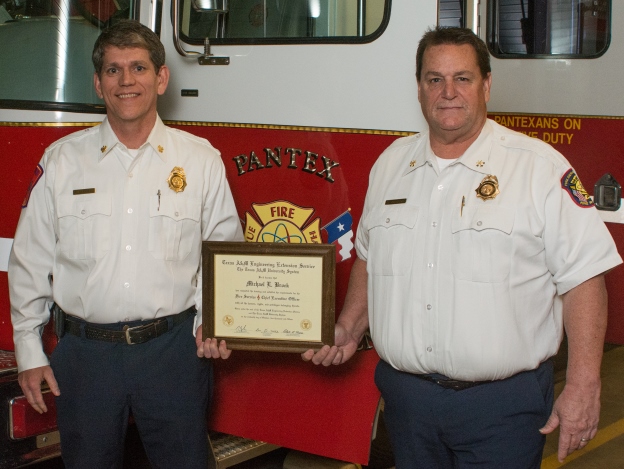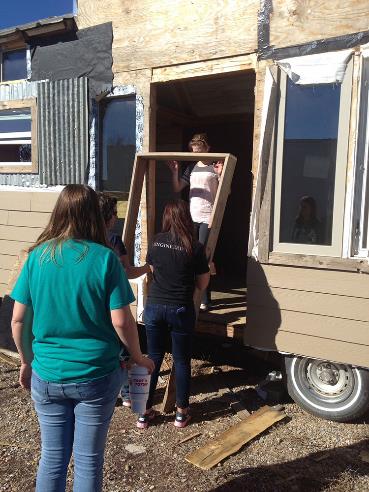Pantex Blog
Pantexans help students ‘bee’lieve in math

A recent Pantex volunteer event wasn’t as easy as 1-2-3 because convincing students that math is a useful skill is difficult, but Pantexans Dee and Scott Weaver were up for the task. The couple led a team of Pantex employees to help about 40 students at the High Plains Children’s Home gain a better understanding of math. Other Pantexans on the team included Laureen Kelly, Tamara Schaef and Leticia Rodriguez. The Weaver’s grandsons, Weston and Ryder, also attended.
“Sometimes it is difficult for students to recognize how much math is used daily,” said Dee Weaver. “When you start looking, math is all around us.” To prove this point, Scott Weaver, a beekeeper, presented “Beekeeping by the Numbers.”
“The kids were fascinated by the information about bees,” Dee said. “It emphasized that math is found in nature in many different ways – from the shape of the honeycomb chambers to the distance a bee will fly to and from the hive.”
At the end of the day, the teams presented graphing calculators to three high school students. “The calculators will help them with their homework and help them stay up with their classmates,” Dee said. “It is one less hurdle they have to overcome to help them be successful in the higher‑level math classes.”
Pantex firefighters attend special training at Texas A&M

Pantex Fire Chief Mike Brock (left) and Battalion Chief Scott Johnson recently completed the Fire Service Chief Executive Officer program offered at Texas A&M University.
For emergency personnel and first responders, constant training is just one facet of the job that is partnered with their daily duties, and it’s no different for Pantex Fire Chief Mike Brock and Battalion Chief Scott Johnson. They both recently attended the Fire Service Chief Executive Officer (FSCEO) program offered at Texas A&M University, through its Texas Engineering Extension Service (TEEX).
A new professional development capstone program for senior chief officers, the FSCEO program, is designed for executives within the fire service.
“The FSCEO course is an excellent way to tie together the information from the Fire Officer 1–4 courses. The instructors from Texas A&M University’s Mays Business School included the most current management and leadership information and challenged the class to apply it to our positions. This was also an excellent chance to attend training with other fire service leaders and discuss the challenges of leading,” according to Chief Mike Brock.
Battalion Chief Scott Johnson noted: “Being in the Fire and EMS services for over 35 years, I have had the opportunity to participate in a number of nationally recognized training programs and attend National Fire Academy courses throughout my career. The Fire Service Chief Executive Officer course has been the highlight of them all. The knowledge of the instructors, course content and ability to network with other leaders in the fire service and pick their intellects about today’s trends in the fire service constituted an excellent value not only for me but for my firefighters. I would highly recommend it to all CNS fire department chiefs.”
Chiefs Brock and Johnson also learned about creativity and innovation, managing change and transition, media relations and stress management. Upon completion of the program, they both received FSCEO certification from TEEX and Texas A&M University.
CNS Sponsors Food Bank’s Annual Food Drive
Consolidated Nuclear Security served as a corporate sponsor during the High Plains Food Bank’s Together We Can food drive Dec. 7-12, providing 16,000 meals, which helped surpass the food bank’s 500,000 meal goal. Pantex volunteers also sorted food donations at the drive on Wednesday, Dec. 9, and others delivered monetary and food donations.

“Pantexans are kind and generous people,” said Laura Bailey, Pantexan and High Plains Food Bank board member. “We asked for volunteers and were flooded with folks who wanted to help. It was a great turnout.”
“As a sponsor, CNS had the opportunity to recognize our employees who do so much for the food bank, raise awareness about the good work performed by the food bank, and thank everyone in the community for their support during the food drive,” Bailey said.
Over the last few months, Pantex has donated $10,000 to the High Plains Food Bank’s Kids Café program and, joined forces with the Metal Trades Council for a donation of $3,250 for general use.
“CNS and MTC’s donations show that the company and employees support the Amarillo area and understand that the basic needs are the most important,” Bailey said. “Hunger kills productivity and potential. Providing food helps people in our community to be healthy, active and more alert. This is especially necessary for children, who need to focus on schoolwork so that they can grow to be healthy, productive adults.”
The High Plains Food Bank reports that the Together We Can food drive received donations for more than 725,000 meals. That will be a huge help because this past year has been particularly difficult, Bailey said. Requests for support have increased, but donations have decreased. Unfortunately, the need in the area is so great that these donations will be distributed within the next few months, she added.
“But I know Pantexans will once again offer to help. That is kind of who we are – Pantexans,” Bailey said.
Looking back at paying it forward
Consolidated Nuclear Security employees at Pantex in Amarillo and Y-12 in Oak Ridge made major impacts in 2015 donating both time and money to worthy causes throughout their communities.
Leading the way at Y-12 was the 12th annual Volunteer Day, with 32 employee-inspired projects from painting, landscaping, cleaning, repairing and even providing learning experiences for young people, all supported by CNS.

Pantex community projects included volunteering with the Amarillo Public Library, cleanup and maintenance of park trails at Palo Duro State Park and Wildcat Bluff Nature Center, and even a few Pantex employees working with a group of Girl Scouts to build a “tiny home” for a mother in need.
“We’re breaking away from the traditional STEM classroom approach,” said Brandy Ramirez, a facility engineer in System Engineering at Pantex. “We’ve put the tools in the girl’s hands allowing them to install new doors and windows. Having a part in building strong, smart, caring young women is very rewarding.”
Education is a strong focus for CNS with Pantex contributing a total of $30,000 to fund multi-level robotics programs at both Amarillo and Bushland Independent School Districts allowing students to take learning high-tech.
Hundreds of students and more than 50 robots, faced off in “the varsity Sport for the Mind™” at the fifth annual Smoky Mountains Regional FIRST Robotics competition in Tennessee. As in previous years, Y-12 employees volunteered as competition judges and as team coaches and mentors to help students design, program, and build a competition robot.
 Perhaps the biggest show of fostering education takes place each February as CNS host regional Science Bowls on behalf of the U. S. Department of Energy (DOE)/National Nuclear Security Administration (NNSA). Middle school and high school students across Texas and Tennessee demonstrate their academic proficiency with the winning teams going on to compete at the National Science Bowl® competition in Washington D.C.
Perhaps the biggest show of fostering education takes place each February as CNS host regional Science Bowls on behalf of the U. S. Department of Energy (DOE)/National Nuclear Security Administration (NNSA). Middle school and high school students across Texas and Tennessee demonstrate their academic proficiency with the winning teams going on to compete at the National Science Bowl® competition in Washington D.C.
“Science Bowl gives students who love math and science an event designed especially for them.” said Michelle Reichert, CNS Vice President and Pantex Site Manager. “They are the next generation of scientists and engineers who will one day help support our important mission.”
This year, CNS President Jim Haynes challenged the Oak Ridge community to match CNS’ $25,000 donation to replace the roof at the Boys & Girls Club of the Clinch Valley. The community responded.
Y-12 Site Manager Bill Tindal presented ADFAC, Aid to Distressed Families of Appalachian Counties, a check for $10,000 allowing the agency to continue its efforts in supporting children and families in need in the area. The donation followed an employee-driven effort where hundreds of dollars and items were collected to replenish ADFAC’s “Crisis Cupboard.” Y-12 employees Elaine Warren and Joy Evans coordinated the effort.
“This donation from Y-12 will go a long way to provide comfort to many families in need,” said Warren. “I know there will be a lot of mothers who will be happy to see diapers and wipes on the shelves at ADFAC,” she added.
CNS also helped to alleviate hunger by presenting $10,000 to the High Plains Food Bank’s Kids’ Café with additional support during December’s Together We Can food drive where employees collected donations of food and cash from the local community. CNS also worked with the Metal Trades Council to help the food bank provide turkeys to families in need during the Thanksgiving holiday.
2015 marked the 17th year for the partnership between Y-12 and Atomic Trades and Labor Council to aid the March of Dimes by donating $15,000 to their campaign. In Amarillo, more than 60 Pantex employees spent a day on the green as CNS contributed $8,000 to sponsor the 25th Annual March of Dimes “Tournament of Eagles” golf tournament.
This year, CNS employees continued their support of the HonorAir flights to Washington D.C., which provides free flights to war memorials for local veterans of World War Two, Korea and Viet Nam. Since 2011, Y-12 employees have turned out for the return flights, wishing our veterans a welcome home and thanking them for their service to our country.

Pantex and Y-12 employees broke a sweat for a good cause at this year’s Susan G Komen Race for the Cure, which saw more than 100 employees at Pantex and Y-12 take part. Curtis Chamberlain, a production manager at Pantex, ran with his 11-year-old daughter and said it was a “good opportunity to spend quality time with her and support a worthy cause.”
CNS and its workforce in Pantex and Y-12 are proud of the support we gave to our communities in 2015 and look forward to even greater good deeds in 2016.
Together We Can feed Amarillo’s hungry
Ask a Pantexan to help and often the reply is, “Tell me when and where.” Recently, the High Plains Food Bank in Amarillo benefitted from Pantexans’ giving hearts. A team of about 40 Pantexans and their family members packed food boxes alongside other community volunteers.

Pantexan Robin McLaurin volunteers her time to pack a food box for the High Plains Food Bank.
The High Plains Food Bank provides food boxes for families who live in areas of the Texas Panhandle that do not have food pantries or partner agencies that provide hot meals with goods from the food bank. The food bank distributes about 1,200 boxes monthly. The Pantex team helped pack 456 boxes, which are shipped out almost as quickly as they are packed. While this event supported the food bank, the volunteers also benefited.
“Packing boxes to feed the less fortunate is a great way to give back to the community. It’s amazing how many communities that the Food Bank provides for especially since they were short in donations this year,” said Pantexan Patti Knipp.
Chelsey Westfall brought her family to help. “I’m so glad that my children and I got the opportunity to make a difference for somebody in need by helping pack food boxes for the High Plains Food bank. Hunger is everybody’s problem, and those of us who are able should all help out wherever we can,” she said.

Pantexans Megan Reed, left, and Laura Bailey, joined Pantex Site Manager Michelle Reichert, right, in presenting a donation to Zach Wilson, HPFB executive director.
CNS and the Metal Trades Council also recently joined forces to provide a donation to the High Plains Food Bank just in time for Thanksgiving. Zach Wilson, HPFB executive director, said the requests for food have greatly increased this year while donations have decreased, leaving a large gap. Michelle Reichert, CNS Vice President and Pantex Site Manager, teamed up with the MTC for a combined donation of $3,250 to help bridge the gap and meet the needs of the Texas Panhandle during the holidays.
And CNS recently served as a corporate sponsor during the High Plains Food Bank’s Together We Can food drive Dec. 7-12, providing 16,000 meals, which helped surpass the food bank’s 500,000 meal goal.
“CNS and MTC’s donations show that the company and employees support the Amarillo area and understand that the basic needs are the most important,” said Laura Bailey, Pantexan and High Plains Food Bank board member. “Hunger kills productivity and potential. Providing food helps people in our community to be healthy, active and more alert. This is especially necessary for children, who need to focus on schoolwork so that they can grow to be healthy, productive adults.”
